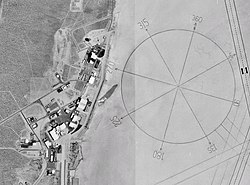Rogers Dry Lake
| Rogers Dry Lake | |
|---|---|

Rogers (center) and Rosamond (lower left) dry lakebeds in Mojave Desert, California
|
|
| Location |
Mojave Desert Kern County, California Los Angeles County, California |
| Coordinates | 34°55′19″N 117°49′39″W / 34.921944°N 117.8275°W |
| Lake type | Endorheic basin |
| Basin countries | United States |
| Max. length | 19 km (12 mi) |
| Max. width | 11 km (6.8 mi) |
| Surface area | 112 km2 (43 sq mi) |
| Shore length1 | 61 km (38 mi) |
| Surface elevation | 694 m (2,277 ft) |
| Settlements | Edwards Air Force Base |
| References | U.S. Geological Survey Geographic Names Information System: Rogers Dry Lake |
|
Rogers Dry Lake
Edwards Air Force Base |
|
 |
|
| Location |
Mojave Desert Kern County, California |
| Coordinates | 34°55′19″N 117°49′39″W / 34.92194°N 117.82750°WCoordinates: 34°55′19″N 117°49′39″W / 34.92194°N 117.82750°W |
| Built | 1933 |
| NRHP Reference # | 85002816 |
| Significant dates | |
| Added to NRHP | 03 October 1985 |
| Designated NHL | 03 October 1985 |
| 1 Shore length is not a well-defined measure. | |
Rogers Dry Lake is an endorheic desert salt pan in the Mojave Desert of Kern County, California. The lake derives its name from the Anglicization from the Spanish name, Rodriguez Dry Lake. It is the central part of Edwards Air Force Base as its hard surface provides a natural extension to the paved runways. It was formerly known as Muroc Dry Lake.
During the extremely brief rainy season, it is possible for there to be standing water on the lakebed, which pools at the approximate low-point elevation of 2,300 ft for the region. The lake is adjacent to the smaller Rosamond Lake which through the Holocene, together made up one large water-body.
Many of the notable aeronautical achievements at Edwards have taken place at Rogers Lake. It is also famous for the world's largest compass rose painted into the lake. It was designated a National Historic Landmark in 1985.
There are seven other official runways on the Rogers lakebed:
...
Wikipedia
